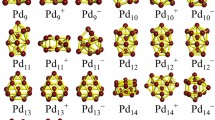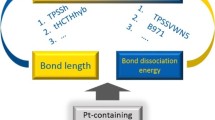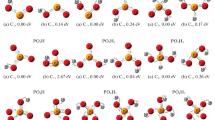Abstract
Using density functional theory, stability, chemical, and optical properties of small platinum clusters, Ptn (n = 2 to 10) have been investigated. An attempt has been made to establish a correlation between stability and chemical reactivity parameters. The calculated geometries are in agreement with the available experimental and theoretical results. The atom addition energy change (ΔE1) and stability function (ΔE2) reveal that Pt7 is more stable than its neighboring clusters. Very good agreement of the calculated electron affinity with the available experimental results has been observed. The polarizability of the Ptn clusters depends almost linearly on the number of atoms. A correlation between the static polarizability and ionization potential is found, paving a way to calculate polarizabilty of larger clusters from their ionization potential. The calculated vibrational frequencies are compared with available experimental and theoretical results and good agreement between them has been established. In general, the prominent peak of molar absorption coefficient is shifting toward the lower energy side when cluster size grows. Our DOS calculation suggests that d orbital is primarily responsible for HOMO position and s orbital is responsible for LUMO position.

Stability and reactivity of platinum cluster








Similar content being viewed by others
References
Sarkar U, Blundell S (2009) Structure and thermodynamics of Fe55, Co55, and Ni55 clusters supported on a surface. Phys Rev B 79:125441–7
Eberhardt W (2002) Clusters as new materials. Surf Sci 500:242–270
Vajda S, Pellin MJ, Greeley JP, Marshall CL, Curtiss LA, Ballentine GA, Elam JW, Mucherie SC, Redfern PC, Mehmood F, Zapol P (2009) Subnanometre platinum clusters as highly active and selective catalysts for the oxidative dehydrogenation of propane. Nat Mater 8:213–216
Bell AT (2003) The impact of nanoscience on heterogeneous catalysis. Science 299:1688–1691
Bond GC (1991) Chemistry of the platinum group metals: recent developments. Elsevier, Amsterdam
Vielstich W, Lamm A, Gasteiger H (2003) Handbook of fuel cells: fundamentals, technology applications. Wiley West, Sussex
Yuan Q, Zhou Z, Zhuang J, Wang X (2010) Pd–Pt random alloy nanocubes with tunable compositions and their enhanced electrocatalytic activities. Chem Commun 46:1491–1493
Tian N, Zhou ZY, Sun SG, Ding Y, Wang ZL (2007) Synthesis of tetrahexahedral platinum nanocrystals with high-index facets and high electro-oxidation activity. Science 316:732–735
Zhang J, Sasaki K, Sutter E, Adzic RR (2007) Stabilization of platinum oxygen-reduction electrocatalysts using gold clusters. Science 315:220–222
Xu Y, Shelton WA, Schneider WF (2006) Effect of particle size on the oxidizability of platinum clusters. J Phys Chem A 110:5839–5846
Ghanty TK, Ghosh SK (1993) Correlation between hardness, polarizability, and size of atoms, molecules, and clusters. J Phys Chem 97:4951–4953
Bedamani N, Sarkar U (2014) A density functional study of chemical, magnetic and thermodynamic properties of small palladium clusters. Mol Simul 40:1255–1264
Dai D, Balasubramanian K (1992) Potential energy surfaces for Pt3 + H and Pd3 + H interactions. J Phys Chem 96:3279–3282
Morse MD (1986) Clusters of transition-metal atoms. Chem Rev 86:1049–1109
Duncan TM, Zilm KW, Hamilton DA, Root TW (1989) Adsorbed states of CO on dispersed metals: a high-resolution solid-state NMR study. J Phys Chem 93:2583–2590
Martin TP, Bergmann T, Golich G, Lange T (1991) Evidence for icosahedral shell structure in large magnesium clusters. Chem Phys Lett 176:343–347
Parr RG, Yang W (1989) Density functional theory of atoms and molecules. Oxford University Press, Oxford
Parr RG, Pearson RG (1983) Absolute hardness: companion parameter to absolute electronegativity. J Am Chem Soc 105:7512–7516
Parr RG, Lv S, Liu S (1999) Electrophilicity index. J Am Chem Soc 121:1922–1924
Chattaraj PK, Sarkar U, Roy DR (2006) Electrophilicity index. Chem Rev 106:2065–2091
Parthasarathi R, Padmanabhan J, Elango M, Chitra K, Subramanian V, Chattaraj PK (2006) pKa Prediction using group philicity. J Phys Chem A 110:6540–6544
Chattaraj PK, Sengupta S (1996) Popular electronic structure principles in a dynamical context. J Phys Chem 100:16126–16130
Ghanty TK, Ghosh SK (1996) A Density functional approach to hardness, polarizability, and valency of molecules in chemical reactions. J Phys Chem 100:12295–12298
Chamorro E, Chattaraj PK, Fuentealba P (2003) Variation of the electrophilicity index along the reaction path. J Phys Chem A 107:7068–7072
Parthasarathi R, Elango M, Subramanian V (2005) Variation of electrophilicity during molecular vibrations and internal rotations. Theor Chem Accounts 113:257–266
Pan S, Sola M, Chattaraj PK (2013) On the validity of the maximum hardness principle and the minimum electrophilicity principle during chemical reactions. J Phys Chem 117:1843–1852
Chandrakumar KRS, Ghanty TK, Ghosh SK (2005) Ab initio studies on the polarizability of lithium clusters: some unusual results. Int J Quantum Chem 105:166–173
Jaque P, Toro-Labbé A (2002) Characterization of copper clusters through the use of density functional theory reactivity descriptors. J Chem Phys 117:3208–3218
Ayers PW, Proft FD, Geerlings P (2007) Comparison of the utility of the shape function and electron density for predicting periodic properties: atomic ionization potentials. Phys Rev A 75:012508–8
Ayers PW, Parr RG (2000) Variational principles for describing chemical reactions: the Fukui function and chemical hardness revisited. J Am Chem Soc 122:2010–2018
Poater A, Duran M, Jaque P, Toro-Labbe A, Sola M (2006) Validity of the minimum polarizability principle in molecular vibrations and internal rotations: an ab initio SCF study. J Phys Chem B 110:6526–6536
Barbatti M, Aquino AJA, Liscka H (2010) The UV absorption of nucleobases: semi-classical ab initio simulations. Phys Chem Chem Phys 12:4959–4967
Soler JM, Artacho E, Gale JD, García A, Junquera J, Ordejón P, Sánchez-Portal D (2002) The SIESTA method for ab initio order-N materials simulation. J Phys Condens Matter 14:2745–2779
Frisch MJ, Trucks GW, Schlegel HB, Scuseria GE, Robb MA, Cheeseman JR, Scalmani G, Barone V, Mennucci B, Petersson GA, Nakatsuji H, Caricato M, Li X, Hratchian HP, Izmaylov AF, Bloino J, Zheng G, Sonnenberg JL, Hada M, Ehara M, Toyota K, Fukuda R, Hasegawa J, Ishida M, Nakajima T, Honda Y, Kitao O, Nakai H, Vreven T, Montgomery JA Jr, Peralta JE, Ogliaro F, Bearpark M, Heyd JJ, Brothers E, Kudin KN, Staroverov VN, Keith T, Kobayashi R, Normand J, Raghavachari K, Rendell A, Burant JC, Iyengar SS, Tomasi J, Cossi M, Rega N, Millam JM, Klene M, Knox JE, Cross JB, Bakken V, Adamo C, Jaramillo J, Gomperts R, Stratmann RE, Yazyev O, Austin AJ, Cammi R, Pomelli C, Ochterski JW, Martin RL, Morokuma K, Zakrzewski VG, Voth GA, Salvador P, Dannenberg JJ, Dapprich S, Daniels AD, Farkas O, Foresman JB, Ortiz JV, Cioslowski J, Fox DJ (2010) Gaussian 09, Revision C.01. Gaussian, Inc, Wallingford
Becke AD (1993) Density-functional thermochemistry. III. The role of exact exchange. J Chem Phys 98:5648–5652
Lee C, Yang W, Parr RG (1988) Development of the Colic-Salvetti correlation-energy formula into a functional of the electron density. Phys Rev B 37:785–789
Perdew JJ, Yang W (1992) Accurate and simple analytic representation of the electron-gas correlation energy. Phys Rev B 45:13244–13249
Hay PJ, Wadt WR (1985) Ab initio effective core potentials for molecular calculations. Potentials for the transition metal atoms Sc to Hg. J Chem Phys 82:270–283
Wadt WR, Hay PJ (1985) Ab initio effective core potentials for molecular calculations. Potentials for main group elements Na to Bi. J Chem Phys 82:284–298
Hay PJ, Wadt WR (1985) Ab initio effective core potentials for molecular calculations. Potentials for K to Au including the outermost core orbitals. J Chem Phys 82:299–310
Barbatti M, Granucci G, Persico M, Ruckenbauer M, Vazdar M, Eckert-Maksić M, Lischka H (2007) The on-the-fly surface-hopping program system NEWTON-X: application to ab initio simulation of the nonadiabatic photodynamics of benchmark. J Photochem Photobiol A 190:228–240
Barbatti M, Granucci G, Ruckenbauer M, Plasser F, Pittner J, Persico M, Lischka H (2013) NEWTON-X: a package for Newtonian dynamics close to the crossing seam, version 1.4, www.newtonx.org
Taylor S, Lemire GW, Hamrick YM, Fu Z, Morse MD (1988) Resonant two-photon ionization spectroscopy of jet-cooled Pt2. J Chem Phys 89:5517–5523
Fortunelli A (1999) Density functional calculations on small platinum clusters: Pt n q (n = 1–4, q = 0,±1). J Mol Struct THEOCHEM 493:233–240
Grushow A, Ervin KM (1997) Ligand and metal binding energies in platinum carbonyl cluster anions: collision-induced dissociation of Ptm − and Ptm(CO)n−. J Chem Phys 106:9580–9593
Yang SH, Drabold DA, Adams JB, Ordejon P, Glassford K (1997) Density functional studies of small platinum clusters. J Phys Condens Matter 9:L39–L45
Kumar V, Kawazoe Y (2008) Evolution of atomic and electronic structure of Pt clusters: planar, layered, pyramidal, cage cubic, and octahedral growth. Phys Rev B 77:205418–10
Tian WQ, Ge M, Sahu BR, Wang D, Yamada T, Mashiko S (2004) Geometrical and electronic structure of the Pt7 cluster: a density functional study. J Phys Chem A 108:3806–3812
Gibson ND, Davies BJ, Larson DJ (1993) The electron affinity of platinum. J Chem Phys 98:5104–5105
Ho J, Polak ML, Ervin KM, Lineberger WC (1993) Photoelectron spectroscopy of nickel group dimers: Ni− 2, Pd− 2, and Pt− 2. J Chem Phys 99:8542–8551
Ervin KM, Ho J, Lineberger WC (1988) Electronic and vibrational structure of transition metal trimers: photoelectron spectra of Ni− 3, Pd− 3, and Pt− 3. J Chem Phys 89:4514–4521
Pontius N, Bechthold PS, Neeb M, Eberhardt W (2000) Femtosecond multi-photon photoemission of small transition metal cluster anions. J Electron Spectrosc Relat Phenom 106:107–116
Wong K, Vongehr S, Kresin VV (2003) Work functions, ionization potentials, and in between: scaling relations based on the image-charge model. Phys Rev B 67:035406–9
Derry GN, Ji-Zhong Z (1989) Work function of Pt(111). Phys Rev B 39:1940–1941
Miller TM (2002) CRC handbook of chemistry and physics. CRC, New York
Mohajeri A, Alipour M (2011) On the optical, electronic, and structural properties of zinc sulfide nanoclusters. Int J Quantum Chem 111:3841–3850
Jansson K, Scullman R (1976) Optical absorption spectra of PtO and Pt2 in rare-gas matrices. J Mol Spectrosc 61:299–312
Solov’yov IA, Solov’yov AV, Greiner W (2004) Optical response of small magnesium clusters. J Phys B Atomic Mol Opt Phys 37:L137–L145
Hughbanks T, Hoffmann R (1983) Chains of trans-edge-sharing molybdenum octahedra: metal-metal bonding in extended systems. J Am Chem Soc 105:3528–3537
Acknowledgments
Dr U. Sarkar acknowledges the support from SHARCNET Canada for providing the computational facilities for this research work.
Author information
Authors and Affiliations
Corresponding author
Electronic supplementary material
Below is the link to the electronic supplementary material.
ESM 1
(PDF 1271 kb)
Rights and permissions
About this article
Cite this article
Singh, N.B., Sarkar, U. Structure, vibrational, and optical properties of platinum cluster: a density functional theory approach. J Mol Model 20, 2537 (2014). https://doi.org/10.1007/s00894-014-2537-5
Received:
Accepted:
Published:
DOI: https://doi.org/10.1007/s00894-014-2537-5




